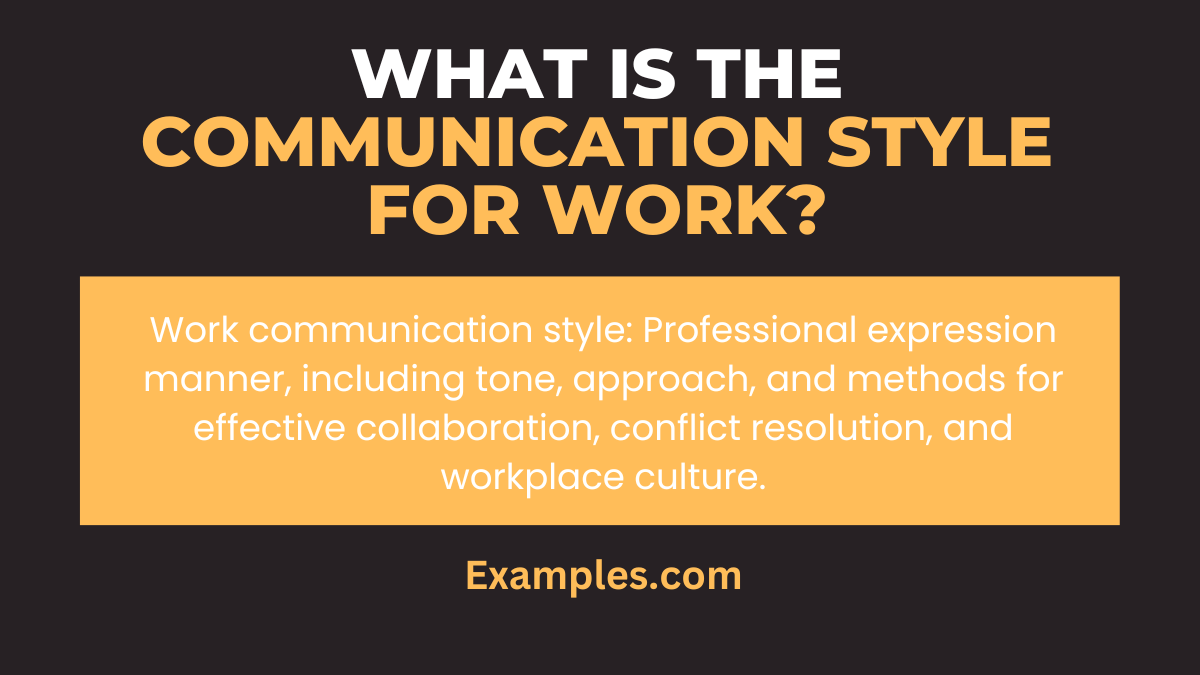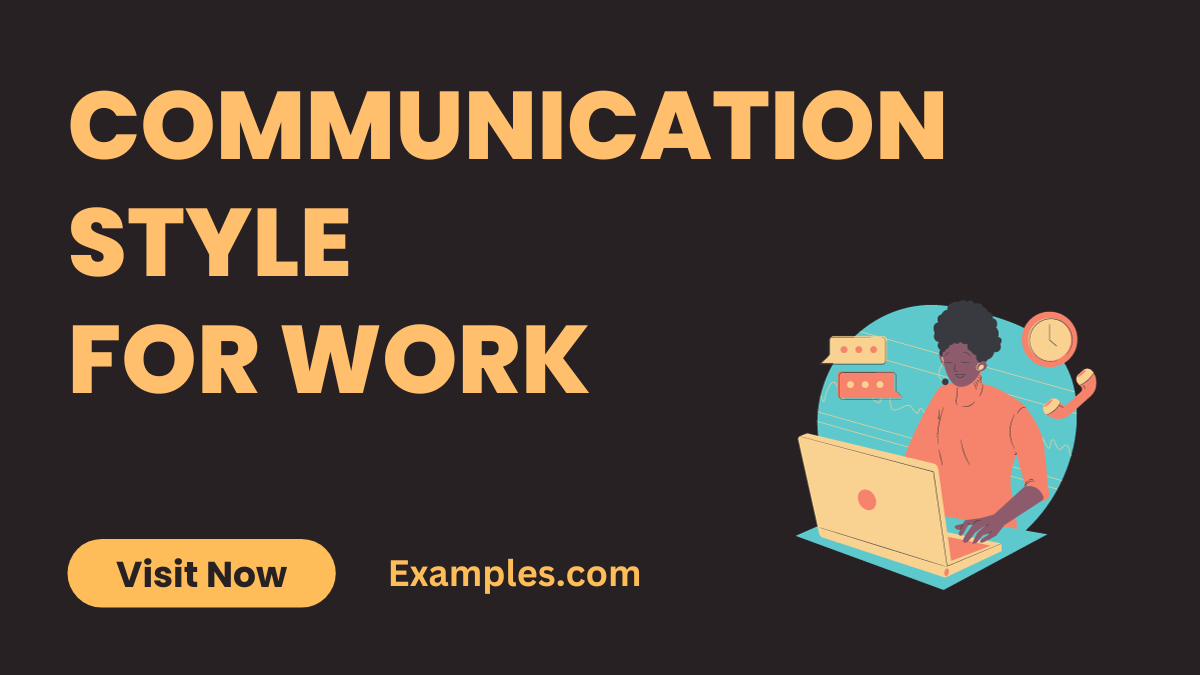19+ Communication Style for Work Examples
Discover the essence of Communication Style for Work through this comprehensive guide. Delve into various Communication Examples in the workplace, understanding their significance and impact. This guide will navigate you through different styles, illustrating how they influence workplace dynamics, team collaboration, and overall productivity. Enhance your understanding and adaptability to foster a more effective and harmonious work environment.
What is Communication Style for Work? – Meaning

Communication style for work refers to the manner in which individuals express themselves in a professional setting. It encompasses the tone, approach, and method used in conveying messages and interacting with colleagues. Understanding these styles is crucial for effective collaboration, conflict resolution, and building a positive workplace culture.
What is the Best Example of Communication Style for Work?

The best example of a communication style for work is often considered to be the assertive style. It involves clear, direct, and respectful communication, balancing one’s own needs with those of others. Assertive communicators express their opinions confidently while being open to feedback, fostering a positive and productive work environment. This style is effective in various workplace scenarios, from team meetings to conflict resolution, as it promotes honesty, respect, and mutual understanding.
20 Communication Style for Work Examples

Explore 20 unique communication styles in the workplace, each with its causes and solutions for improvement. This guide offers insights into how various styles – from Assertive to Passive-Aggressive – impact workplace interactions and productivity, and how to effectively navigate them for a harmonious work environment.
- Assertive: Direct, clear communication.
Cause: Confidence. Fix: Balance assertiveness with empathy. - Passive: Avoids confrontation.
Cause: Low confidence. Fix: Encourage assertive expression. - Aggressive: Dominant, often confrontational.
Cause: Overconfidence. Fix: Foster respectful communication. - Passive-Aggressive: Indirect negativity.
Cause: Avoidance. Fix: Encourage open dialogue. - Analytical: Focuses on facts, details.
Cause: Logical mindset. Fix: Add personal touch. - Intuitive: Relies on instincts.
Cause: Emotional approach. Fix: Balance with factual data. - Functional: Process-driven, detailed.
Cause: Methodical approach. Fix: Encourage big-picture thinking. - Personal: Relationship-oriented.
Cause: People-focused. Fix: Balance with task focus. - Collaborative: Team-oriented communication.
Cause: Cooperative nature. Fix: Foster individual accountability. - Directive: Commanding, instructive.
Cause: Leadership role. Fix: Encourage feedback. - Expressive: Emotionally expressive, persuasive.
Cause: Charismatic personality. Fix: Focus on substance. - Reflective: Thoughtful, considers all angles.
Cause: Analytical nature. Fix: Encourage timely decision-making. - Casual: Informal, relaxed.
Cause: Comfort-focused. Fix: Maintain professional standards. - Manipulative: Influencing, often hidden motives.
Cause: Strategic mindset. Fix: Promote transparency. - Empathetic: Understanding, caring.
Cause: Compassionate nature. Fix: Balance with objectivity. - Concise: Brief, to the point.
Cause: Efficiency-focused. Fix: Encourage detailed explanations when needed. - Influencer: Inspiring, motivating.
Cause: Charismatic nature. Fix: Align inspiration with practical goals. - Listener: Attentive, patient.
Cause: Supportive nature. Fix: Encourage active participation. - Questioner: Inquisitive, often probes deeper.
Cause: Curious nature. Fix: Guide towards relevant inquiries. - Open: Welcoming, encourages sharing.
Cause: Inclusive nature. Fix: Ensure focused discussions.
Passive Aggressive Communication Style for Work
A Passive Aggressive Communication Style at work often leads to a lack of direct communication, affecting team dynamics and productivity.
- Indirect Criticism: Expressing dissatisfaction subtly. “I suppose late work is the norm now.”
- Avoiding Direct Confrontation: Expressing anger indirectly. “Nothing’s wrong, I’m fine.”
- Sarcasm as a Defense: Masking true feelings. “Sure, I love doing extra work.”
- Reluctant Agreement: Agreeing but not following through. “I’ll do it, but don’t expect miracles.”
- Silent Resentment: Holding grudges silently. “I don’t have an opinion on this.”
Personal Communication Style for Work
A Personal Communication Style in the workplace involves open, empathetic, and individualized interactions, enhancing Communication Styles in Relationships.
- Empathetic Engagement: Showing understanding. “I can see why that’s important to you.”
- Personal Insights: Sharing from personal experience. “In my previous role, I tackled a similar challenge.”
- Casual Interactions: Engaging informally. “How was your weekend? I enjoy hiking too!”
- Specific Praise: Acknowledging personal contributions. “Your detailed report was really helpful.”
- Personalized Approach: Tailoring communication to individual preferences. “I’ve noticed you prefer emails, so I’ll update you that way.”
Amicable Expressive Communication Style for Work
Amicable Expressive Communication Style in the workplace fosters a positive, supportive environment, crucial for Communication Styles in Leadership.
- Friendly Openness: Encouraging a welcoming atmosphere. “Let’s all share our ideas openly here.”
- Encouraging Collaboration: Promoting team participation. “I value everyone’s input on this project.”
- Warm Acknowledgments: Appreciating team efforts. “Your dedication to this task is commendable.”
- Positive Reinforcement: Building confidence through affirmation. “Your innovative approach really made a difference.”
- Inclusive Discussions: Ensuring everyone’s voice is heard. “I want to make sure we consider all perspectives.”
Functional Communication Style for Work
Functional communication style at work focuses on more than just information exchange; it’s about understanding and conveying emotions and intentions. Key aspects include becoming an engaged listener, paying attention to nonverbal signals, and maintaining stress control. Engaged listening involves not just understanding the words, but also the emotions behind them. Nonverbal communication, like facial expressions and body language, plays a crucial role. Managing stress is essential for clear, Effective Communication. To learn more about these skills and improve your work and personal relationships, visit article on Effective Communication and Coursera’s guides on Effective Communication and Improving Communication.
How Communication Styles Can Influence Culture at Workplace?
- Identify Varied Styles: Recognize different Communication Styles Examples, from Assertive to Reflective, each contributing uniquely to workplace culture.
- Impact of Leadership Styles: Understand how a Communication Style for Leaders influences trust and collaboration, while an Aggressive Style might create competitiveness.
- Cultural Shaping: Acknowledge how styles like Communication Style for Project Managers or Communication Style for Students shape the organizational culture through their functional or open approaches.
- Create a Positive Environment: Use diverse communication styles to cultivate a positive, inclusive, and productive workplace environment.
How to Work with Different Communication Styles?
- Recognize Diversity: Identify the various Communication Styles for Workplace, understanding their unique contributions to team dynamics.
- Harmonize Styles: Learn to blend different styles, such as the persuasive Communication Style for Influencer with the direct Communication Style for Managers.
- Embrace Casual Interactions: Utilize a Casual Communication Style for informal engagements, building stronger rapport and understanding.
- Foster Openness and Transparency: Incorporate an Open Communication Style to promote honesty and trust within the team.
- Adapt and Adjust: Be adaptable to different styles, especially in roles involving Communication Style for Coaching or Communication Style for Relationships, to enhance personal development and team cohesion.
What Are the Types of Communication Styles?
The four Types of Communication Styles are Assertive, Passive, Aggressive, and Passive-Aggressive. Each style impacts interactions and can be identified through Communication Style Assessment.
What Is the Communication Style in the Workplace?
Workplace communication style often combines Assertive and Open styles, focusing on clarity and collaboration. Effective styles are crucial for Communication Style with Management and team dynamics.
What Are the main Communication Styles?
The five Communication Styles Assertive, Passive, Aggressive, Passive-Aggressive, and Manipulative. Understanding these helps in how to improve communication style, enhancing workplace interactions.
In conclusion, understanding and mastering various communication styles at work, from Assertive to Passive-Aggressive, is crucial for a harmonious and productive workplace. Recognizing these styles helps in effective interaction, conflict resolution, and building a cohesive team environment. Embracing diversity in communication leads to improved collaboration and overall success in any professional setting.



